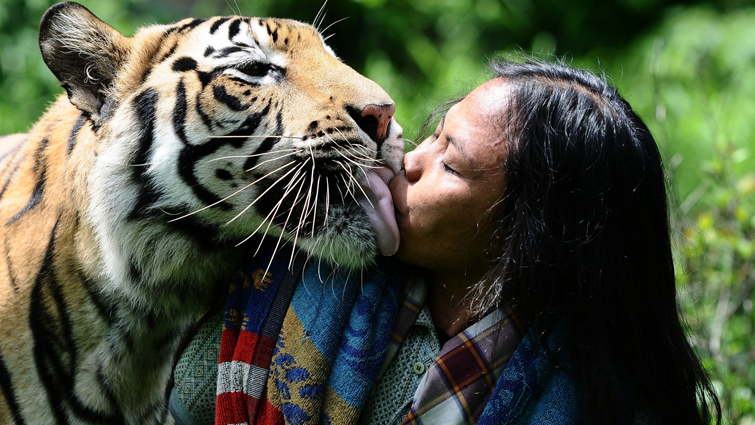
08 Mar, 2018
20 Facts You Probably Didn’t Knew About Tigers
Tigers are often looked as being one of the most beautiful yet ferocious animals and perhaps this is a sole driving factor that makes them even more interesting creatures. But sadly, they have come to a verge of being categorized as endangered, thanks to the human sloppiness and prudence. As a wildlife lover with keen interest on large cats, I enjoy visiting wildlife sanctuaries but the question remains, how well do I or we know about this exotic animal? We’re often clouded by many misconceptions with other large cat species, but hopefully, you’ll learn something about them through this blog where I’ve listed some facts about tigers. Spoiler alert - you would be knowing some of the facts already but what the hell!
1. Tigers are the largest amongst other wild cats

You probably knew this that Royal Bengal Tigers are the largest amongst other wild cats but did you also know that the male Tigers weigh up to 300 kilograms. Jezz! That’s like weighing a group of six average human. All they have to do is sit on top of you licking their paws, you’d be dead instantly.
2. A punch from a Tiger may kill you

Leaving aside Tigers enormous body size, just look at their front-hands/legs, if you have a pet Tiger and a brutal enemy, you might as well send them for a fist fight. Kidding, you cannot have a pet tiger, it illegal! It is said that one swipe from a Tiger’s front hand is enough to kill a person or an animal, or at least break one’s bones.
3. Tigers are nocturnal animals

It is not necessarily true that all Tigers are nocturnal but yes, they do prefer engaging in most of their hunting activities at night. The reason behind this is that Tigers prefer avoiding human conflict during daylight and also patrol around their territory at night.
4. Tiger cubs are born blind and only half of the cubs survive

The saddest part is that Tiger cubs are born blind and only a few survive. Literally, the newborn cubs can't see anything, they only follow the scent of their mother. Since they are born blind and can't keep up, most of them die of hunger or cold. Some even get eaten by male Tigers to make the Tigress available for mating. That’s just insane!
5. Tigers love to swim and play in the water

Unlike the domestic cats, its larger version enjoy spending time in the water and they love to swim for hours. Since cubs, female Tigers encourage or help learn the art of hunting, they even have the ability to kill in the water. And as adults, it is said that they can swim for several kilometres and even have reported one to swim for 30 km in just a day.
6. Tigers live for about 25 years

The life expectancy of Tigers is between 20-25 years whether they are kept in captivity or in the wild. However, most die before the age of 20, like for instance, the death of a nineteen-year-old Machli in Ranthambore National Park, Rajasthan, India. The oldest living Tiger so far was 25-year-old Flavel, a circus-rescued, sheltered in a zoo in Tampa, Florida.
7. A group of Tigers are called an ambush or streak

The Tigers are forced into unnatural situations where they are to share or stay-put under certain areas in a man-made environment, that’s when they are called as ambush or streak, even a Tigress with their cubs is called an ambush.
8. Tigers can mate with other big cats

Tigers can also mates with other big cats, for example, if a male Tiger mates with female Lion, the hybrid born animal is known as Tigon. They are the largest cat species and can grow bigger than Liger which is a mix breed of male Lion and female Tiger. The height of a Liger is about 4.5 feet while on all four legs and about 6 feet tall when standing.
Note: You can find Tigons in at least nine countries that include USA, Czech Republic, China, Iran, Russia, India, UAE and Argentina. Cross breeding of tigers are banned in Taiwan.
9. Tigers have antiseptic saliva

Perhaps, a good side of Tigers is that they have antiseptic saliva, so whenever you get a bruise and want to disinfect them, visit the doctor Tiger, just kidding! Usually what they do is, they tend to lick the area in order to prevent any infection.
10. Tigers can sprint at over 60 kilometre/hour

Not the fastest runner in the animal kingdom but the fact that Tigers have very strong legs makes them sprint more or less than 60 kilometres per hour, but it is only possible for short distances.
11. Tiger stripes are also found on their skin

Most of you may not know this but, most of the cat species have stripes on their fur as well as on their skin. It is actually true that similar to human fingerprints, the unique pattern of stripes on Tigers acts like their identity. Even if you shave off the fur of Tigers or house cats, you would still see the stripes.
Note: Do not try this at home with domestic pets.
12. Tigers rarely roar and are humble towards their group

I know, by generous, you must be like, what? But just so you know, Tigers are one of the most humble species unlike Lions (no offence). Often it is seen in the wildlife that the male Tigers allow the female and cubs to eat first.
13. Tigers urine smells like buttered popcorn

Here’s an interesting fact, the smell that emits from Tigers urine smells like buttered popcorn, don’t get tempted because it also signifies a warning sign to the intruders in their territory.
14. Tigers prefer to hunt by ambush

Photo: https://goo.gl/YvbGSQ
One of the most common knowledge to any wildlife lovers, wild animals enjoy a surprise kill but not as much as Tigers. Due to their stripe camouflage, they hide behind thick bushes and attack their victim from behind. It is also said that Tigers are less likely to attack when we see them, in fact, most of the villages in India wear a face mask on the back of their head just to trick the Tigers.
15. Tigers are solitary creatures

Photo: https://goo.gl/Uei1WU
It is true, Tigers are considered as solitary animals. Unlike the sights of multiple tigers kept in one cage in the zoos, you are less likely to spot the same age group of tigers roaming together in the wild. Tigers like to stay alone, they are often observed taking a leisure walk all by themselves or perhaps building his strategies for his next meal (LOL).
16. Tigers have diverse diet

Photo: https://goo.gl/d9CHxq
The Tigers have a varied diet and can feast on anything that comes its way, be it, a wild boar, deer/antelope, rodent, bear, bird, rhino, crocodile, buffalo and even their own group of cats like leopards. They even eat fish!
17. Tigers can imitate the call of other animals

Tigers imitate the call of other animals! I had that same expression and it aroused me to dig deeper and found a positive answer, they certainly can. Hunting by mimicry is an added advantage to animals; it has been said that Tigers make a ‘pook’ sound similar to that of sambhar that draws these innocent animals into the trap and get ambushed.
18. Tigers do not normally view humans as a prey

Photo: https://goo.gl/4cF5KE
Tigers tend to attack humans only when they feel threatened unless you look delicious (humour). But on a serious note, we cannot deny that fact, there have been reports on Tigers killing people in rural places, so it is best to stay away from their territory. If you come across such situations, it is best to walk backwards, constantly eyeing the Tiger, as mentioned earlier, as they mostly kill in ambush.
19. A Tiger’s penis does not erect even when aroused

Photo: https://goo.gl/pYrgjV
Apparently, a Tiger’s penis doesn’t erect even when aroused and there is a logical reason behind it as an internal extra-skeletal baculum or a penis bone does all the work. It is present in all mammals and primates, drifting at the end of the penis. Baculum results best in sexual procreation, resulting in great advantages to the male by locking the process mid-sex and preventing a female to mate with others before his sperm completely gets absorbed. You must have seen such instances between dogs, think!
20. Tigers cannot purr

Photo: https://goo.gl/fkKMf1
There have been many debates if Tigers can purr, but there are some instances that mention Tigers do purr (occasionally) but this is probably done just for argument sake. Although, Tigers do make other loud noises (not purring). However, other wild cats like Cheetahs and Jaguars can purr but only when they exhale, but if it is an actual purr or something else, the question still remains?
Note: In order to show content or calmness, these species tend to close their eyes (even domestic cats) showing their comfort level and a safe feeling.
Here to the 20 facts about Tigers you just read, did it give you something to talk with your friends later? I hope it did. These creatures are simply beautiful and super cuddly as cubs but I’d prefer to wave at them from my safari jeeps. Despite all the tiger fact talks, why do we need to save these giant cats you ask? Well, look back and think again. Let us read how can we save the Tigers from poaching and hunting.
Where do we stand today in safeguarding Tigers?
Tigers are one of the most beautiful animals in the world, no wonder it is considered the national animal of India. Its black and orange stripes put these solitary animals apart from the rest of the species. Just for the record, India has around 70 percent of the tiger population in the whole world (standing ovation please). Slowly but gradually, we can see a remarkable difference in wildlife ever since killing and selling of tigers skin was banned. In fact, back in 2016, World Wildlife Fund (WWF) declared the tiger population in India to have risen dramatically. Today, amongst the eight, we are surrounded by only five subspecies of tigers like Siberian, Sumatran, the Great Bengal, South China and Indochinese; the extinct three species are Javan, Bali, and Caspian.
How can we start to save the Wildlife and Tigers?
What an individual can do to protect the tigers is perhaps by spreading the word, the Tigers are constantly under threat due to copious infrastructures. Although there have been restrictions in certain areas that are dedicated to wildlife, there have been constant reports on tigers wandering in the rural villages. One can always be a responsible tourist by maintaining silence and not disturbing the animals. And also, try to reduce using natural resources from forests like paper and help in forest conservation. Phew! So much to learn and so much to talk about animal rights but if you keep reading our blogs, we’ll make sure you get more interesting wildlife topics to read about.
NOTE: This blog post is scribbled by Abhishek Gurung.











 Share
Share Home
Home Packages
Packages Book Now
Book Now